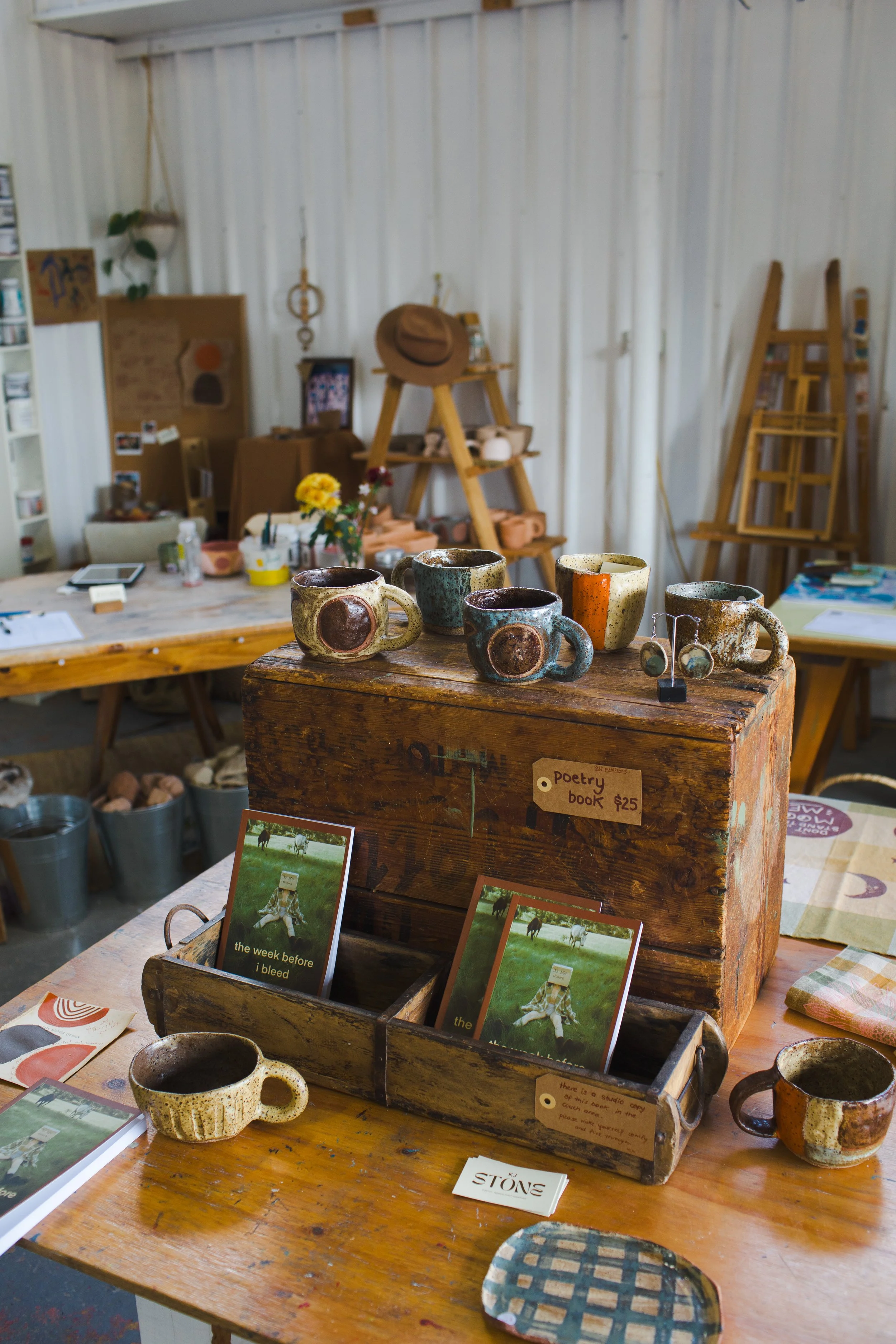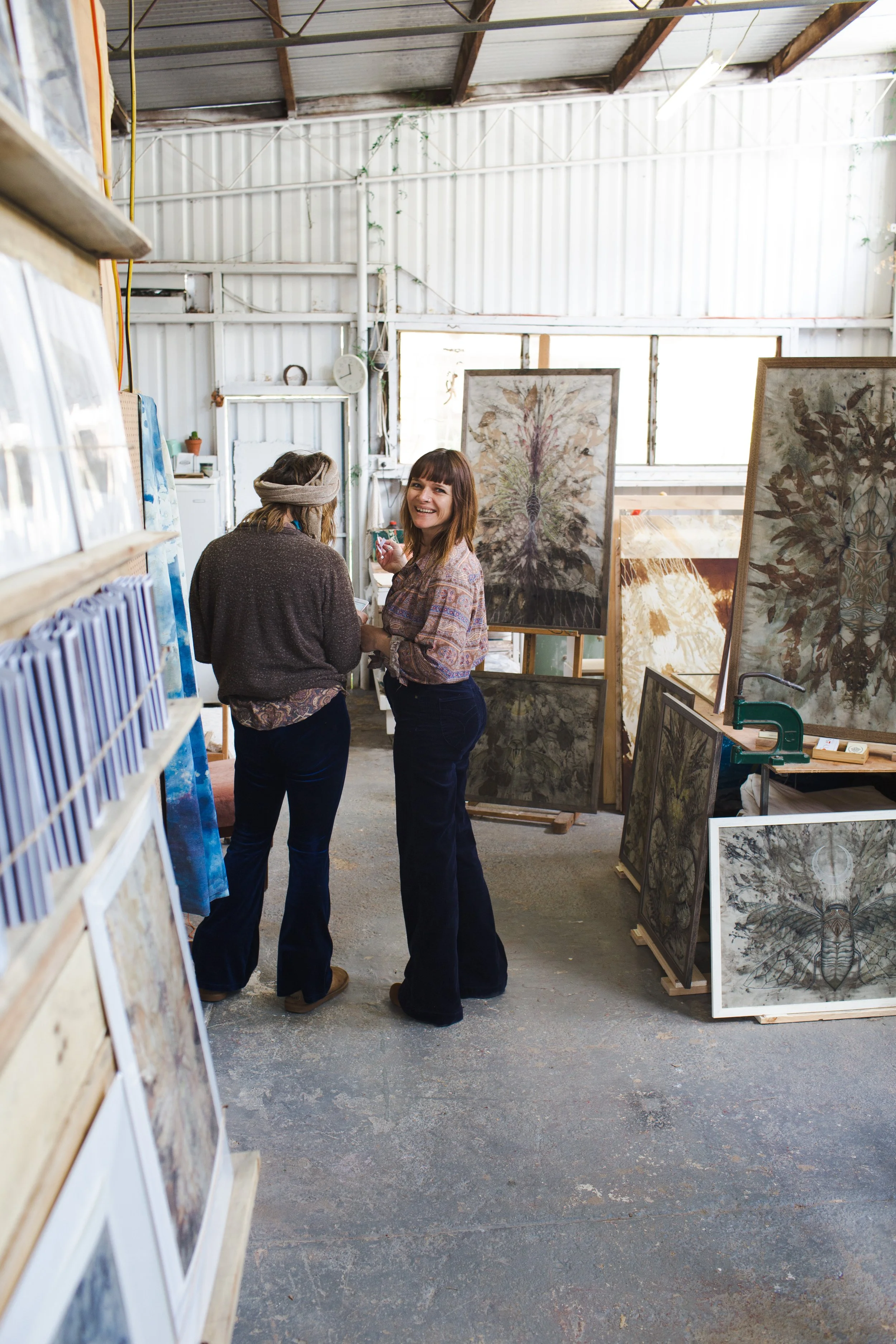Margaret River Open Studios
Taking a tour of Australia’s largest open studios event.
This review was published in ARTShub magazine
Image by Peter Hill.
For two weeks, the Margaret River region becomes an orienteering landscape for studio voyeurs. Generous artists open their doors and visitors are invited into their creative worlds, each local space displaying its unique fingerprint of artistic expression and mood.
Touring the medley of studios – that seemingly erupt to life in concert with the bloom of spring – feels like wandering through a collection of short stories, united only so far as their geography and shared compulsion to make art. Fortunately, there’s no further attempt to blanket a uniformed theme onto this vast event. It’s free of that restriction.
Photographers; painters; textile, ceramic and jewellery artists; authors; woodworkers and sculptors emerge from their winter isolation to share their works. Some display pieces are soon to be shipped off for exhibition, others works shown are from the vault (in some cases, you walk into the vault itself, leafing through dusted canvases in overflow sheds), there are works suspended in a state of maturing development and finished creations ready for purchase.
These are the studios that captivate the event in all its grand simplicity:
Trevor Clement – woodworker
Five days prior to the event, Clement’s studio was his dust-covered woodwork shop. With the help of his daughter, Lilith – who sits with a warm smile on the adjacent outdoor loveseat as visitors arrive – the workshop now rests quietly as an authentic backdrop to his intricate display of woodworking mastery. Crafted geometric shapes bind together like a kaleidoscope, forming keepsake boxes, wooden sculptures (shaped perfectly to exhibit as a light fixture), cheeseboards and statement earrings. Clement exaggerates these psychedelic patterns with combinations like curly blackbutt against stained jarrah and pine veneers pressed into she-oak.
As you pass through the open roller door, artists and carpenters alike chat about his rudimentary table saw jigs, homemade wood clamps and local firewood foraging. Here, like all of the studios this reviewer visits, the artist’s story is inseparable from his work.
KJ Stone – poet, potter, photographer
‘My work is not about mass production; everything I make is a slow, purposeful creation,’ says Stone. And this is how your mood changes you cross the threshold into her shared studio – slow and purposeful, as if we are being offered the chance to throw time itself into the industrial retailers behind us.
Sitting in the floral armchairs of Stone’s eclectic world, visitors can pick up her poetry book, the week before i bleed, and read their own experiences out loud, take imaginary sips of tea from her nonuniform pottery and play with the bowl of clay beads left out for that exact purpose. There’s a romance to her art – its earthy, curved femininity is a force that flows heart-first. This reviewer rested and let her words ‘bring back the swing in my hips and the taste of life on my lips’.
Jodie Thompson – textile, print artist and Chloe Wilder – painter, drawer, ceramicist, woodworker
The studio space that holds Stone’s creations is shared with Jodie Thompson and Chloe Wilder. These three women are all artists and mothers – dissolving the illusion that one part of life can exist in isolation to another.
While each of their disciplines holds a unique imprint, there’s a unified attitude to the space. Their children are here, creating their own works of art on the floor. Vinyl records play, incense burns and visitors feel an immediate ease to just be. As you wander to the back of the studio, Thompson’s large-scale textile pieces fill the room; detailed insects are illustrated onto naturally dyed raw silks via an ancient technique that Thompson describes as a process to get lost in. ‘There is a mystery to this kind art,’ she says. ‘I can’t plan or control the output, so I just let go.’ Her natural dye baths are made from binding raw silk onto a rusted metal pole with collected eucalyptus leaves; the effect is a mesmerising piece of inimitable art.
Wilder’s large-scale oil works adorn the walls of the shared studio space. Like nests decorated with every colour found on the forest floor, her paintings are a bold celebration of aliveness – politically angled as if asking for a dialogue that wills a new perspective to emerge. In this exact exchange, her first collection, I Stole Your Face, was intended to be a commentary on social media data security, but instead became a way for women to see themselves in a new, positive form. This feedback became the catalyst for her current works exhibited in Open Studios – women in communion with the cycles of the natural world, ready to be noticed.
Kerry Sibly – painter, sculptor
Sibly’s studio, which begins when you step out of your car and onto the garden path, is a respite of humour. His eclectic upcycled sculptures pay tribute to everything from The Wizard of Oz to Matthew Dixon’s Transmissions and The Thinker. While his sculpture work leans heavily on familiar references, his home studio – a converted shearing shed – is where you step into Sibly’s distinctive creations: for this event, it’s cow portraits.
The angles he chooses are as if the cows, painted with acrylic on recycled rusted iron canvases, have something of vitality to share, a unique perspective to broadcast. And that’s exactly how Sibly sees it. Having painted all 42 cow sculptures that populate his small town of Cowaramup, his work is iconic to the region, a reputation he extends into the work on display for Open Studios.
Peter Hill – photographer, mixed media
Landscape photography of WA’s south-west often follows a predictable blueprint – coastal or forest subjects with sedentary wildlife posed among a replica colour palette. But Peter Hill’s work, while traversing the same over-shot spots, is theatrical. He uses neutral density filters over a long-exposed technique to capture the drama of the location. ‘The rocks themselves are evidence of the violent action of the water. It’s dynamic but strangely calm,’ says Hill. ‘It feels like being in an orderless dream.’
Hill’s hand-held proclivity is then put aside to produce his most intriguing images. On a surveying assignment after the Brisbane floods, he used photogrammetry to produce 3D imagery – a tool that later became a creative outlet. His obscure image of a Myanmar laneway – that comes with a story of cultural reclaim – is captured with 40/60-degree tilted data collection points and a sweeping of black streams where no data is reported. These zones are like black holes of contemplation – the art of errors.
This piece was edited and published by ARTShub magazine.



